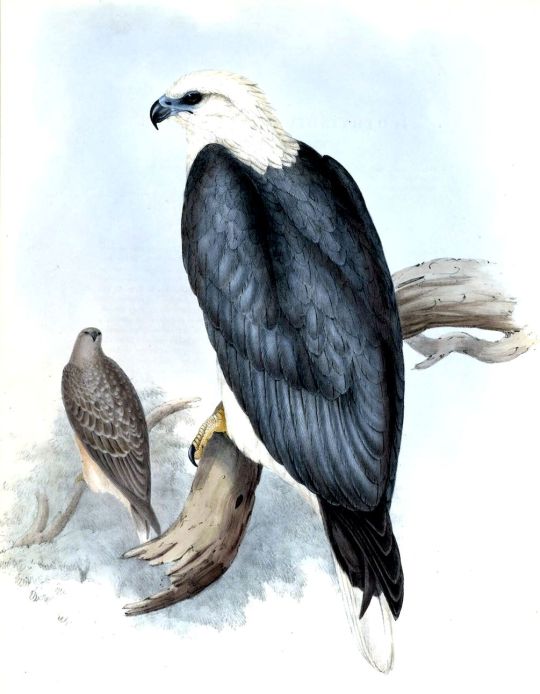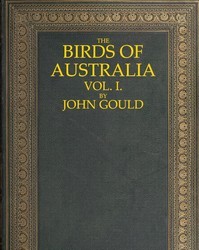Text

HALIASTUR LEUCOSTERNUS.
White-breasted Sea-Eagle.
Girrenera, Aborigines of New South Wales.
Me-ne-̏u-roo, Aborigines of the Cobourg Peninsula.
"In size and in the general markings of its plumage, this beautiful species is more closely allied to the Falco Ponticerianus of Latham, than to any other; but the total absence of the coloured stripe down the centre of the white feathers which clothe the head, neck and breast of the Australian bird, at once distinguishes it from its Indian ally.
The White-breasted Sea Eagle is very common on the northern and eastern portions of Australia, where it takes up its abode in the most secluded and retired parts of bays and inlets of the sea.
...The chief food of this species is fish, which it captures either by plunging down or by dexterously throwing out its foot while flying close to the surface of the water; such fish as swim near the surface being of course the only ones that become a prey to it: sometimes the captured fish is borne off to the bird’s favourite perch, which is generally a branch overhanging the water, while at others, particularly if the bird be disturbed, it is borne aloft in circles over the head of the intruder and devoured while the bird is on the wing, with apparent ease. Its flight is slow and heavy near the ground, but at a considerable elevation it is easy and buoyant.
...
The sexes are so much alike in colour that it is by the greater size of the female alone that they are to be distinguished; the young, on the other hand, differ considerably from the adult.
Head, neck, chest and upper part of the abdomen snow white; back, wings, lower part of the abdomen, thighs, upper and under tail-coverts rich chestnut red; first six primaries chestnut at the base and black at the tip; tail-feathers chestnut red on their upper surface, lighter beneath, the eight central feathers tipped with greyish white; irides light reddish yellow; cere pale yellowish white; orbits smoke-grey; upper mandible light ash-grey at the base, passing into sienna-yellow and terminating at the tip in light horn-colour; under mandible smoke-grey; tarsi cream-yellow, much brighter on all the large scales on the front of the tarsi and toes.
0 notes
Text

White-bellied Sea Eagle
ICHTHYIAËTUS LEUCOGASTER.
It has neither the boldness nor the courage of the Wedge-tailed Eagle, Aquila fucosa... it it never plunges beneath the surface of the water, but depends almost entirely for its subsistence upon the dead Cetacea, fish, etc., that may be thrown up by the sea and left on the shore by the receding waves; to which, in all probability, are added living mollusks and other lower marine animals: its peculiar province is consequently the sea-shore, and it especially delights to take up its abode on the borders of small bays and inlets of the sea, and rivers as high as they are influenced by the tide; nevertheless, it is to be met with, though more rarely, on the borders of lakes and inland streams, but never in the forests or sterile plains of the interior.
...Unless disturbed or harassed, the White-bellied Sea-eagle does not shun the abode of man, but becomes fearless and familiar. Among the numerous places in which I observed it was the Cove of Sydney, where one or two were daily seen performing their aërial gyrations above the shipping and over the tops of the houses: if I mistake not, they were the same pair of birds that found a safe retreat in Elizabeth Bay, skirting the property of Alexander Macleay, Esq., and where they might be frequently seen perched on the bare limb of a tree by the water’s edge, forming an interesting and ornamental addition to the scene.
This Sea-eagle may be frequently seen floating about in the air above its hunting ground, in circles, with the tips of its motionless wings turned upwards; the great breadth and roundness of the pinions, and the shortness of the neck and tail, giving it no inapt resemblance to a large butterfly.
The sexes are alike in plumage, but the female is considerably larger than her mate.
Adults have the head, neck, all the under surface, and the terminal third of the tail-feathers white; primaries and base of the tail blackish brown, the remainder of the plumage grey; irides dark brown; bill bluish horn-colour, with the tip black; cere, lores, and horny space over the eye bluish lead-colour slightly tinged with green; legs and feet yellowish white; nails black.
The young have the head, back of the neck and throat light buff; all the upper surface and wings light chocolate-brown, each feather tipped with buffy white; tail light buffy white at the base, passing into deep brown towards the tip, which is white; chest brown, each feather margined with buff; abdomen mingled buff and brown, the latter colour occupying the margins of the feathers; under tail-coverts, and the under surface of the tail-feathers white; bill brown; feet yellowish white.
The Plate represents an old and a young bird, the former about half the natural size.
0 notes
Text

Little Australian Eagle.
"I shall perhaps better convey an idea of the rarity of this small but true species of Aquila, by stating that the specimen from which the accompanying drawing was made, and which forms part of my own collection, is the only one I have ever seen either living or dead. "
"Face, crown of the head and throat blackish brown, tinged with rufous, giving it a striated appearance, bounded in front above the nostrils with whitish; feathers at the back of the head, which are lengthened into a short occipital crest, back of the head, back, and sides of the neck, all the under surface, thighs and under tail-coverts rufous, all but the thighs and under tail-coverts with a stripe of black down the centre of each feather; back, rump and wings brown, the centre of the wing lighter; primaries brownish black, becoming darker at the tip, and barred throughout with greyish buff, which is conspicuous on the under surface, but scarcely perceptible on the upper, except at the base of the inner webs; under surface of the wing mottled with reddish brown and black; tail mottled greyish brown, crossed by seven or eight distinct bars of blackish brown, the tips being lighter; cere and bill lead-colour, passing into black at the tip; eye reddish hazel, surrounded by a narrow blackish brown eyelash; feet and toes very light lead-colour."
0 notes
Text
You apply for 20 jobs on Indeed. The silence is deafening.
You apply for 20 jobs on Indeed. Half of them require you to create an account on the company website. You leave a trail of ghost accounts that will be used once and never again. You never receive a response.
You apply for 20 jobs on Indeed. One employer offers an interview, but it's so rare for you to receive any response that you forget to check the website and you miss the time.
You apply for 20 jobs on Indeed. One employer offers an interview, but you don't know the magic words that signal to the esoteric mind of an interviewer that you're fit for the job.
You apply for 20 jobs on Indeed. One employer e-mails you saying that 'unfortunately, you do not have the qualifications we are looking for'. You check the job again and see you applied to be a menial labourer.
You apply for 20 jobs on Indeed. Half of them require a car. No one stops to ask how you're supposed to afford one with no job.
You apply for 20 jobs on Indeed. One employer offers a job. The commute makes you want to die in your sleep.
You call the HR manager for the workplace in hopes of arranging an interview more directly. They don't even have an answering machine.
Employers complain that no one wants to work anymore.
65K notes
·
View notes
Text

The first bird in the book (once past the index, an alphabetical list of "subscribers", the division of all birds into genus and location and the inclusion of a surprising number of anecdotal letters about birds from subscribers), is the Wedge-tailed Eagle.
"This noble bird is so universally spread over the southern portion of Australia, that it is quite unnecessary for me to enter more minutely into detail respecting the extent of its range, than to say that it is equally distributed over the whole of the country from Swan River on the west to Moreton Bay on the east; it is also as numerous in Van Diemen’s Land, and on all the larger islands in Bass’s Straits..." "In all probability it will hereafter be found to extend its range as far towards the tropics in the southern hemisphere as the Golden Eagle (Aquila chrysaëta) does in the northern: the two birds are, in fact, beautiful analogues of each other in their respective habitats, and doubtless perform similar offices..."
" its tremendous stoop and powerful grasp, in fact, carry inevitable destruction to its victim, be it ever so large and formidable. The breeders of sheep find in this bird an enemy which commits extensive ravages among their lambs, and consequently in its turn it is persecuted unrelentingly by the shepherds of the stock-owners, who employ every artifice in their power to effect its extirpation... The tracts of untrodden ground and the vastness of the impenetrable forests will, however, for a long series of years to come afford it an asylum, secure from the inroads of the destroying hand of man; still with every one waging war upon it, its numbers must necessarily be considerably diminished."
"The adults have the head, throat, and all the upper and under surface blackish brown, stained on the edges and extremities of many of the feathers, particularly the wing and upper tail-coverts with pale brown; back and sides of the neck rusty-red; irides hazel; cere and space round the eye yellowish white; bill yellowish horn-colour, passing into black at the tip; feet light yellow.
"The young have the head and back of the neck deep fawn-colour, striated with lighter; all the feathers of the upper surface largely tipped and stained with fawn and rusty-red; tail indistinctly barred near the extremity; throat and breast blackish brown, each feather largely tipped with rufous; the abdomen blackish brown."
1 note
·
View note
Text

Books I would like to read and suddenly realised I CAN read, because Project Gutenberg is wonderful: The seven volumes of the Goulds' 1848 book of Australian Birds. I say the Goulds plural because Elizabeth Gould, John's wife was critical to the illustrations: she died before it was completed but most if not all of the prints are based on her drawings.
0 notes